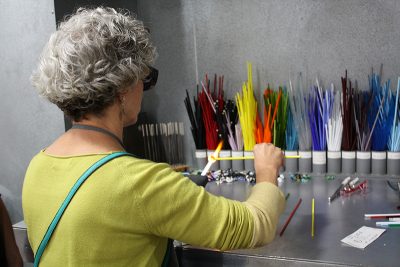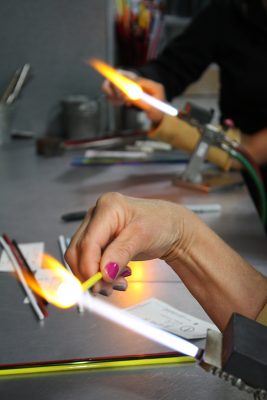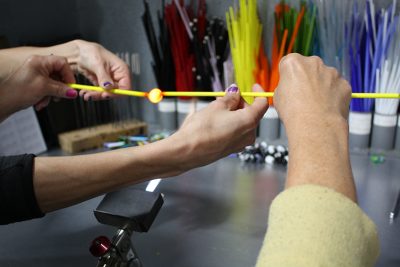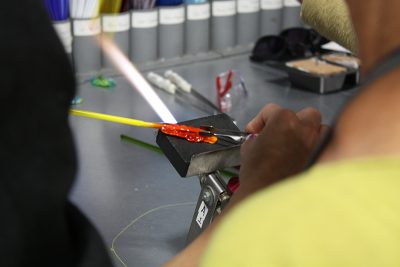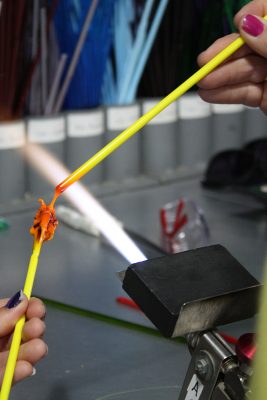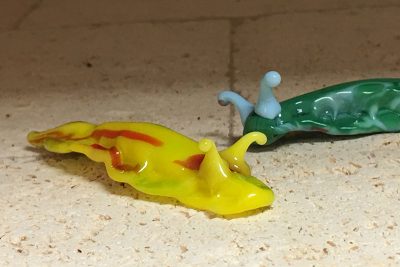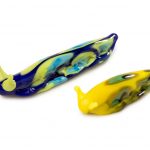
Have you seen our new Make Your Own Glass project? It’s adorable! It’s a flameworked sea slug, more specifically a nudibranch – a soft-bodied marine gastropod mollusk.
This year, in conjunction with our newest show, Fragile Legacy: The Marine Invertebrate Glass Models of Leopold and Rudolf Blaschka, the Make Your Own Glass Workshop is giving visitors the chance to create their very own flameworked marine invertebrate.
I had a chance to sit down with Kalli Snodgrass, the designer of this hands-on project. We spoke about how she got started in glass and what it takes to design a new project for the Make Your Own Glass Workshop.
Kalli is a Workshop Coordinator here at The Corning Museum of Glass. If you have been to the Museum before, you may recognize her. She’s worked across the Museum, both in the Make Your Own Glass Workshop and demonstrating for Properties and Materials shows in the Innovation Center.
Kalli hails from Pennsylvania, where she first saw glassblowing. She enrolled at Keystone College with an interest in casting metal but soon found a passion for glass. Kalli began working in the Hot Shop as a glassblower and, once at CMOG, she expanded her skills to include flameworking. Under the tutelage of Eric Goldschmidt, flameworking and properties of glass supervisor, Kalli quickly began to appreciate some of the differences between glassblowing and flameworking. Kalli describes flameworking as “accessible and meditative” along with the added bonus of being an affordable way to work with glass.
As a flamework demonstrator at the Museum, there is occasional downtime between demonstrations and demonstrating artists often walk the galleries looking for inspiration. It was during one of these trips that Kalli first saw the Blaschka models. She was impressed by the quality of work the father and son duo produced with very rudimentary equipment. Kalli was also drawn to the purpose of the objects: “They were doing it for scientific reasons, but the objects themselves are beautiful art pieces.”
Tasked with designing a hands-on project for the public themed around Fragile Legacy, she began searching for sea creatures that could be reproduced in the MYOG workshop. Several sea-themed options were suggested and the sea slug was chosen.
How does one design a good project for Make Your Own Glass? Well, there are several factors that go into that decision.
- Size – flameworked projects have to be small enough to anneal properly so that participants can pick them up the next day.
- Timing – projects need to be completed in a 40-minute session.
- Complexity – the slug has to be simple enough that someone with no experience can complete the project successfully.
- Safety – the participant and the MYOG instructor have to be safe as the object is made in a 4,000 degree flame.
- Age – flameworked projects have to be simple enough that a 10-year-old can do them but engaging enough that someone at 90 would still be interested.
With all of these factors to consider you can see why creating a new MYOG project is a daunting task, Kalli’s sea slug is well-suited for this job, simple but engaging and perfectly themed for our Fragile Legacy exhibition.
Where will you keep your slug? Kalli recommends a potted plant, perhaps a fish tank or even as an office buddy. Show us where you keep yours using #imadeglass.
- Docent Lynn Woodard begins to form the body of her sea slug.
- Using a mixture of natural gas and oxygen, the 4,000 degree flame melts the glass stick into a ball.
- Kalli and Lynn stretch the molten glass ball into a sea slug body.
- The body is defined using a small set of flat crimps.
- Stretching the glass to make the sea slug’s antenna.
- Finished sea slug in the annealer.


